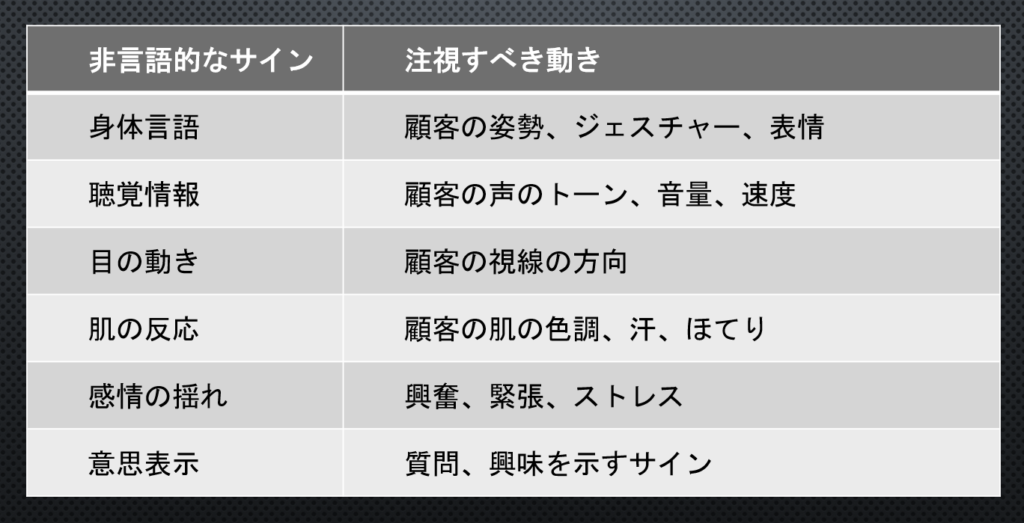
結論から言えば、リモートだけでは非常に難しいと言えます。
リモートでも購買に繋げることが出来たケースがあると言われるかもしれませんが、その場合には情報提供を行う前に顧客は既に購買の意思をほぼ固めているはずです。
つまり既に認知、関心、欲求まで行動変容モデルが進んでおり、比較・検討から実際の購買行動の手前にあるため、購入サポートを行えば購買につなげることが出来る状況にあります。
すなわち、購買意思の無い顧客に対して、認知、関心から欲求までの行動変容を促すには対面営業の方がリモートによる情報提供よりも購買インパクトは格段に効果的といえます。
メラビアンの法則をご存知でしょうか?
メラビアンは、人間のコミュニケーションにおいて、言葉(言語)が情報伝達のわずか7%にしか貢献しないとし、音声の声のトーンやリズムなどの非言語要素が38%、そして身体言語や顔の表情などの非言語要素が55%の情報伝達に影響を与えると主張しました。
顧客を購買に向かわせるためには、顧客から発せられるノンバーバルな情報を読み取ることが重要です。
優れた営業パーソンは、無意識のうちに顧客に合せる、経験や勘といった言語化が難しい主観的な知識である『暗黙知』に優れています。
ではどのようなノンバーバルな情報に注視すれば良いでしょうか?
腕を組んでいる、身を乗り出しているあるいは椅子に深く腰掛けている、つま先が外を向いているなど(添付図参照)、対面でしか得られない情報が90%以上も存在します。
リモートによる情報提供だけでは不十分である理由をご理解していただけたでしょうか?
Title: Can Remote Information Delivery Drive Customer Purchase Behavior?
In conclusion, it can be challenging to rely solely on remote methods to drive customer purchase behavior.
While there may be cases where remote methods have successfully led to purchases, in such instances, customers likely already had a strong intention to make a purchase even before receiving information. This means they had progressed through the stages of awareness, interest, and desire in the consumer behavior model, leaving them in a position to be guided towards a purchase after receiving support.
In other words, when dealing with customers who do not yet have a purchase intent and are in the stages of transitioning from awareness to interest and desire, face-to-face interactions tend to have a significantly more impactful effect compared to remote information delivery.
Are you familiar with Mehrabian’s Law?
Mehrabian suggested that in human communication, only 7% of the message is conveyed through words (language), while 38% is influenced by vocal elements such as tone and rhythm, and 55% is attributed to non-verbal cues like body language and facial expressions.
To guide customers towards making a purchase, it is crucial to read the non-verbal cues they emit.
Skilled salespeople excel in adapting to customers using tacit knowledge – subjective, unspoken understanding that includes experience and intuition.
So, what non-verbal cues should you focus on?
Non-verbal cues like crossed arms, leaning in, or deep seating, and the orientation of the toes (see attached diagram) provide information that is mostly accessible in face-to-face interactions.
Have you come to understand why relying solely on remote information delivery is often insufficient?

